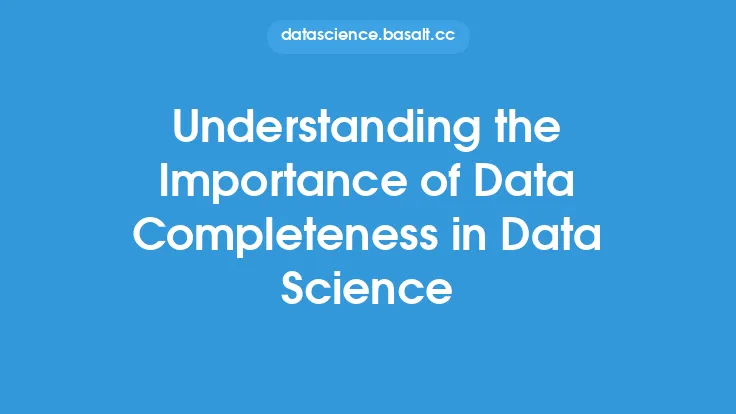Data lineage is a critical component of data science, as it provides a clear understanding of the origin, processing, and movement of data throughout its lifecycle. It is the process of tracking and documenting the data flow, transformations, and relationships between different data entities. Data lineage is essential in ensuring data quality, reliability, and transparency, which are fundamental to making informed business decisions. In this article, we will delve into the importance of data lineage in data science, its benefits, and the technical aspects of implementing a data lineage system.
What is Data Lineage?
Data lineage is the ability to track and record the data flow, including all transformations, processing, and movement of data from its origin to its final destination. It involves creating a map of the data journey, including all the systems, processes, and people involved in handling the data. Data lineage provides a clear understanding of how data is created, processed, and used, which is essential for ensuring data quality, reliability, and transparency.
Benefits of Data Lineage
Data lineage offers several benefits, including improved data quality, increased transparency, and enhanced reliability. By tracking the data flow, organizations can identify errors, inconsistencies, and anomalies in the data, which can be corrected to improve data quality. Data lineage also provides a clear understanding of how data is used, which can help organizations to identify potential security risks and ensure compliance with regulatory requirements. Additionally, data lineage enables organizations to track the provenance of data, which is essential for ensuring the accuracy and reliability of data-driven decisions.
Technical Aspects of Data Lineage
Implementing a data lineage system requires a deep understanding of the technical aspects of data management. There are several approaches to implementing data lineage, including manual tracking, automated tracking, and hybrid approaches. Manual tracking involves manually documenting the data flow, which can be time-consuming and prone to errors. Automated tracking involves using software tools to track the data flow, which can be more efficient and accurate. Hybrid approaches involve combining manual and automated tracking methods to provide a comprehensive view of the data flow.
Data Lineage Tools and Technologies
There are several data lineage tools and technologies available, including data catalog tools, data integration tools, and data governance tools. Data catalog tools provide a centralized repository of metadata, which can be used to track the data flow and provide a clear understanding of the data journey. Data integration tools provide the ability to integrate data from multiple sources, which can be used to track the data flow and provide a comprehensive view of the data journey. Data governance tools provide the ability to manage and govern data, which can be used to ensure compliance with regulatory requirements and ensure data quality.
Data Lineage and Data Quality
Data lineage is closely related to data quality, as it provides a clear understanding of the origin, processing, and movement of data. By tracking the data flow, organizations can identify errors, inconsistencies, and anomalies in the data, which can be corrected to improve data quality. Data lineage also provides a clear understanding of how data is used, which can help organizations to identify potential security risks and ensure compliance with regulatory requirements. Additionally, data lineage enables organizations to track the provenance of data, which is essential for ensuring the accuracy and reliability of data-driven decisions.
Data Lineage and Data Governance
Data lineage is also closely related to data governance, as it provides a clear understanding of the data flow and how data is used. By tracking the data flow, organizations can ensure compliance with regulatory requirements and ensure data quality. Data lineage also provides a clear understanding of how data is used, which can help organizations to identify potential security risks and ensure compliance with regulatory requirements. Additionally, data lineage enables organizations to track the provenance of data, which is essential for ensuring the accuracy and reliability of data-driven decisions.
Implementing Data Lineage
Implementing a data lineage system requires a deep understanding of the technical aspects of data management. There are several steps involved in implementing a data lineage system, including identifying the data sources, tracking the data flow, and documenting the data journey. Organizations should also establish a data governance framework to ensure compliance with regulatory requirements and ensure data quality. Additionally, organizations should provide training and support to employees to ensure that they understand the importance of data lineage and how to implement it effectively.
Challenges and Limitations
Implementing a data lineage system can be challenging, as it requires a deep understanding of the technical aspects of data management. There are several challenges and limitations involved in implementing a data lineage system, including the complexity of the data flow, the lack of standardization, and the limited resources. Organizations should also be aware of the potential risks and limitations of data lineage, including the potential for errors, inconsistencies, and anomalies in the data. Additionally, organizations should be aware of the potential for data lineage to be used for malicious purposes, such as data tampering or data theft.
Best Practices
There are several best practices involved in implementing a data lineage system, including establishing a data governance framework, providing training and support to employees, and using data lineage tools and technologies. Organizations should also ensure that they have a clear understanding of the data flow and how data is used, which can help to identify potential security risks and ensure compliance with regulatory requirements. Additionally, organizations should regularly review and update their data lineage system to ensure that it remains effective and efficient.
Conclusion
Data lineage is a critical component of data science, as it provides a clear understanding of the origin, processing, and movement of data throughout its lifecycle. It is essential for ensuring data quality, reliability, and transparency, which are fundamental to making informed business decisions. By implementing a data lineage system, organizations can improve data quality, increase transparency, and enhance reliability. Additionally, data lineage enables organizations to track the provenance of data, which is essential for ensuring the accuracy and reliability of data-driven decisions. As data continues to play an increasingly important role in business decision-making, the importance of data lineage will only continue to grow.





